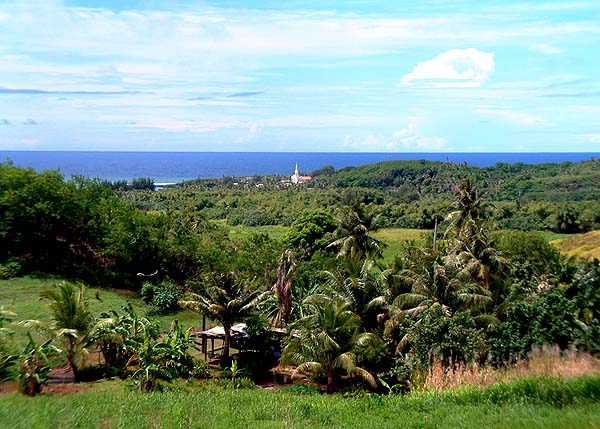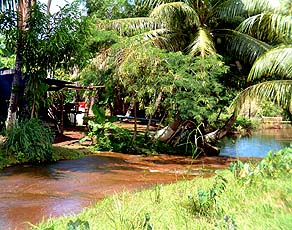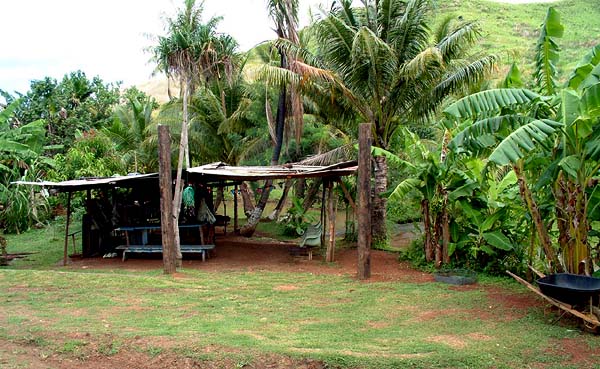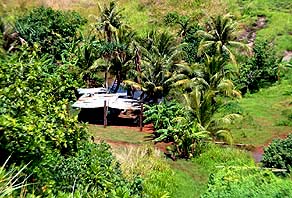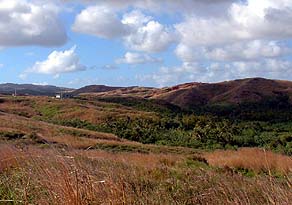 |
 |
 |
 |
||||
|
|
|
|
|
|
|
|
|
|
|
|||||||
|
|
|
|
A ranch sits nestled in the hills above Inarajan village.
|
|
|
“The Spanish viewed the land as the source of the sins,” Anne reminds us, “because of the belief in spirits and the connection to the burials. The Spanish wanted people buried in cemeteries, but the Chamorros buried their dead in their land, and that all tied together: this is where you live, this is where you are buried, this is where your spirits are. From the Spanish perspective, to get people away from all of those pagan ideas was a part of Christianization, because as long as they are surrounded by this ‘paganism’ then true Christianity would have been difficult. So I think that was the intention."
|
||
|
|
||
|
"But it wasn’t very successful, because you notice in the villages like Inarajan, the houses were so close together that it didn’t leave room for farming. So the Spanish allowed the people to farm on their land. That’s why the Chamorro families today all have ranches. That’s where people keep their pigs and do their farming, and that was the ancestral land, so that connection wasn’t really broken. And the ancestral land even to this day, the ranches, that’s all clan land.
|
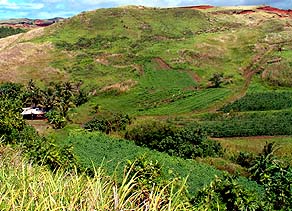
|
|
|
"The ranch concept started way back in the Spanish time," Joe explains, "and this is told from one mouth to another mouth, that the ranch is actually where you became Chamorro. You had a lot of rules, and a lot of laws, that sort of prohibited the Chamorros from being Chamorros. And so you follow the rules at home, at your house, where you sleep, because you were watched then. "Then a lot of people would have a home away from home, and that’s their actual, real home at the ranch. That’s where they become Chamorros; that’s where you don’t have to use napkins, and you don’t throw your leftover food in the trash bin, you throw it outside so the chickens can eat it, and that’s where you throw your water, whatever water is in your cup, you can just throw it out and it’s fine, it’s okay.
|
|
|
|
|
|
|
"But you don’t do like that at your house, because the Americans or the Spanish taught you that you don’t do that. So the concept of the ranch was really to become a Chamorro, to do a lot of the things that colonial powers did not permit us to do." Sherey adds, "If someone says 'Oh, let’s go to my ranch,' it’s a way of inviting you to their home, but you’re not to expect that it’s very elaborate, not to expect too much. 'This is my home, and it’s very small.' A place where people don't boast about themselves, and what they have."
|
||
|
|
||
|
"The ranch is where you kick back and you enjoy yourself. Just like the olden days, you have your place where you just sleep if you’re going to spend the night, or just in the afternoon take a siesta. You have a small shack where you sleep and then you have another small shack where you cook, and then another small shack where you put all your tools of the trade, in farming. They were temporary shelters, the significance of that is that it’s not a ‘permanent’ thing because your permanent house is at your village home."
|
|
|
|
“There might be chickens, pigs, it all depends,” Therese explains, “because if they were to have animals there, then somebody would have to go there every day to feed the animals. Often times it was just a ranch with no animals, just a place to go and relax and enjoy. Often times they will farm, but again, unless there’s somebody everyday to water the plants or to take care of the animals and the plants, then usually it’s just a something away from home. "Sometimes it’s a retreat from work. On the weekends they go in their four-by-fours and no matter how rugged the roads are and no matter how wet and muddy it is, everybody just has fun trying to get there. People would go in to go off-roading and to get away from the hustle and bustle of going to work."
|
|
|
|
|
"So, relaxation was to go into the ranches and barbeque, gather with family, tell stories, just hang out and have some fun with everybody." We will learn more about the use of the land in Inarajan. But first, we turn our attention to the sea.
|
||
|
|
||
|
|
|
|
|
|

|
| Inarajan Home | Map Library | Site Map | Pacific Worlds Home |
|
|
|
|
|
|
|
|||
| Copyright 2003 Pacific Worlds & Associates • Usage Policy • Webmaster |
|||
